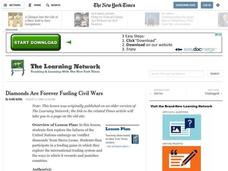Curated OER
Civil War Soldiers
Learners investigate the concept of having a draft for obtaining military forces. They conduct research in small groups using a variety of resources in order to answer key questions. The ideas of having a volunteer army instead is shared...
Curated OER
Slavery in America at the Time of the Civil War
Eighth graders create simple html pages as a vehicle for presenting the Inspiration web. In this American History activity, 8th graders research slavery in the United States.
Curated OER
Lincoln and the "Writ of Liberty"
Students debate and explore the rationale and ethics behind Lincoln's 19th century suspension of habeas corpus - the 'writ of liberty' and answer related questions.
Curated OER
Resistance to African American Education During and After the Civil War
Learners research a web site of primary documents to determine the level of support among whites in for the education of African Americans during Reconstruction.
Curated OER
Exploration of Civil War Webquest
Young scholars use the internet to research what life was like for Confederate and Union soldiers in a specific battle of interest to them. In groups, they complete a webquest on the battle in which one represents a Confederate soldier...
Curated OER
After the Civil War: Segregation
Students study the Civil War. For this American history lesson, students define segregation, make a segregation collage with pictures of people being separated from others because of their race, religion, or ethnic background, and write...
Curated OER
Freedom Timeline
Students explore the issue of the morality of slavery in the 18th and 19th centuries in the United States and construct a timeline containing freedom facts. Freedon issues and the rights and responsibilities of the time are examined.
Curated OER
Lesson Plan - The Barbara Frietchie Story – Fact or Fiction?
Students differentiate between fact and legend. In this Barbara Freitchie lesson, students read poetry and non-fiction accounts regarding the story of Freitchie. Students analyze the story of the American patriot to determine how much of...
Curated OER
Can you Prove it?
Tenth graders examine how primary source documents help authors and museum curators interpret historic events. In this social studies lesson, 10th graders research primary source documents. Students create a powerpoint to...
Curated OER
Was There an Industial Revolution? Americans at Work Before the Civil War
Students tabulate the First Industrial Revolution where a significant number of inventions and innovations appeared transforming American life. Cite examples of change (ex. telegraph) in the lives of Americans during the era of question....
Curated OER
Diamonds Are Forever Fueling Civil Wars
Students explore the failures of the UN embargo on conflict diamonds from Sierra Leone. They participate in a trading game to explore the international trading system and the ways in which it rewards and punishes countries.
Curated OER
Breaking the Chains: Rising Out of Circumstances
Study history through photographs. In this visual arts and history instructional activity, students learn to analyze photographs to discover details about life during the Civil War era. Students write journal entries as if they are the...
Curated OER
The Civil Rights Movement
Students analyze the tensions that existed in American society during the Civil Rights Era as well as the problems that children experienced. They evaluate editorial cartoons dealing with the American Civil Rights movement to view the...
Alabama Department of Archives and History
Strange Fruit: Lynching in America
To continue their study of the Civil War, Reconstruction, and the beginning of the civil rights movement, class members watch the YouTube video of Billie Holiday singing "Strange Fruit" as an introduction to an examination of...
Curated OER
The Changing Meaning of "Due Process"
Students examine the United States Constitution and how the application for due process differs in two amendments. They research the changing definition of the term since the Civil War. They use the internet to research press coverage of...
TED-Ed
A Digital Reimagining of Gettysburg
Why would Robert E. Lee order Pickett's Charge, an action that changed the course of the Civil War? Geographer and historian Anne Knowles uses digital technology to explain what she thinks is the missing piece in trying to understand...
Curated OER
Women in the War
Pupils make decisions about how best to deal with or resolve dilemmas during the Civil War. In this women in war lesson, students word in groups to discuss how a given dilemma could be handled. Groups elect a spokesperson to report to...
Curated OER
1862 MARYLAND CAMPAIGN, AMERICAN CIVIL WAR
Students explain why General Robert E. Lee decided to invade Maryland in September 1862; review the major events of the Maryland Campaign of 1862; describe the major events of the three phases of the Battle of Antietam; and assess the...
K12 Reader
An Interview with President Lincoln
What would you ask Abraham Lincoln if you had the chance? Class members draft interview questions for the 16th U.S. President, and imagine what his responses would be.
DocsTeach
Juneteenth General Order
While Juneteenth was more than 150 years ago, today Americans debate whether it should be a national holiday. Using a military declaration proclaiming the last of the enslaved people in Texas free, individuals look at the significance of...
DocsTeach
Analyzing a Photograph of Clara Barton
Just who was Clara Barton? Using an archive photo from the National Archives, class members consider the legacy of the founder of the American Red Cross. The activity includes the photograph, along with prompts to help young scholars...
Common Core Sheets
Placing Events on a Timeline
Put important events in chronological order with a lesson about timelines. With a variety of topics stemming from world history, the packet of worksheets provides analytical activity for learners to decide where certain events fall...
Center for History and New Media
Growing Up in a Segregated Society, 1880s–1930s
What did segregation look like in the beginning of the 20th century? Middle and high schoolers view images of segregated areas, read passages by Booker T. Washington and W.E.B. DuBois, and come to conclusions about how the influence of...
K12 Reader
Slavery in the Constitution
Your young historians will read excerpts from three parts of the United States Constitution—Article One, the Thirteenth Amendment, and the Fourteenth Amendment—and discuss how they each address the issue of slavery.
Other popular searches
- The Civil War Amendments
- The Civil War Battles
- Music of the Civil War Period
- The Civil War Unit Plan

























